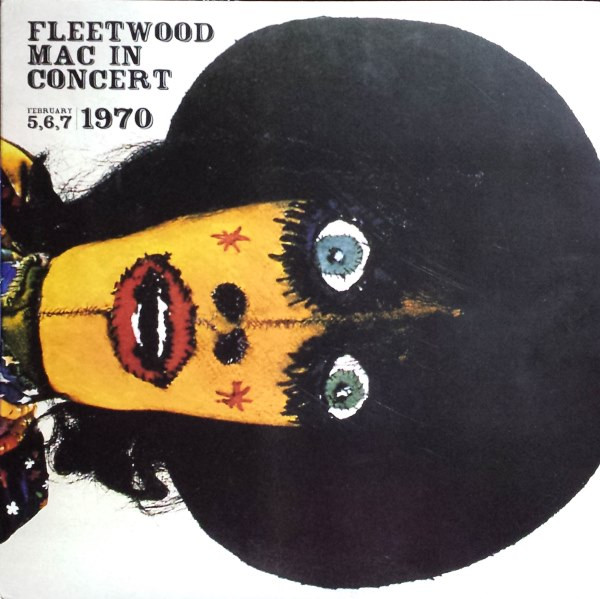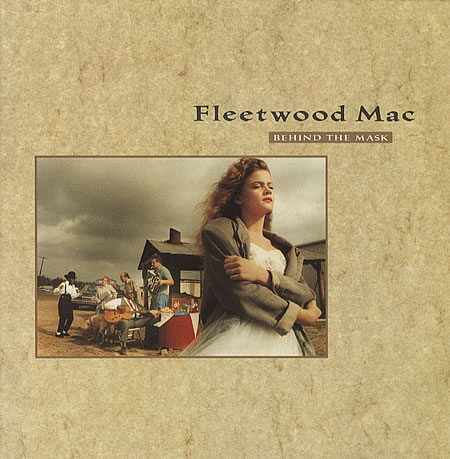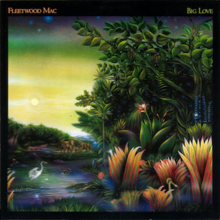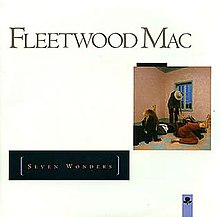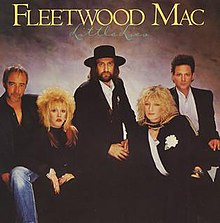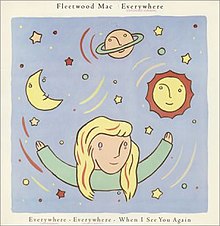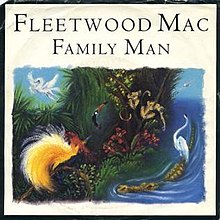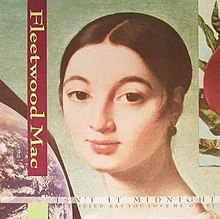
Rock and roll music
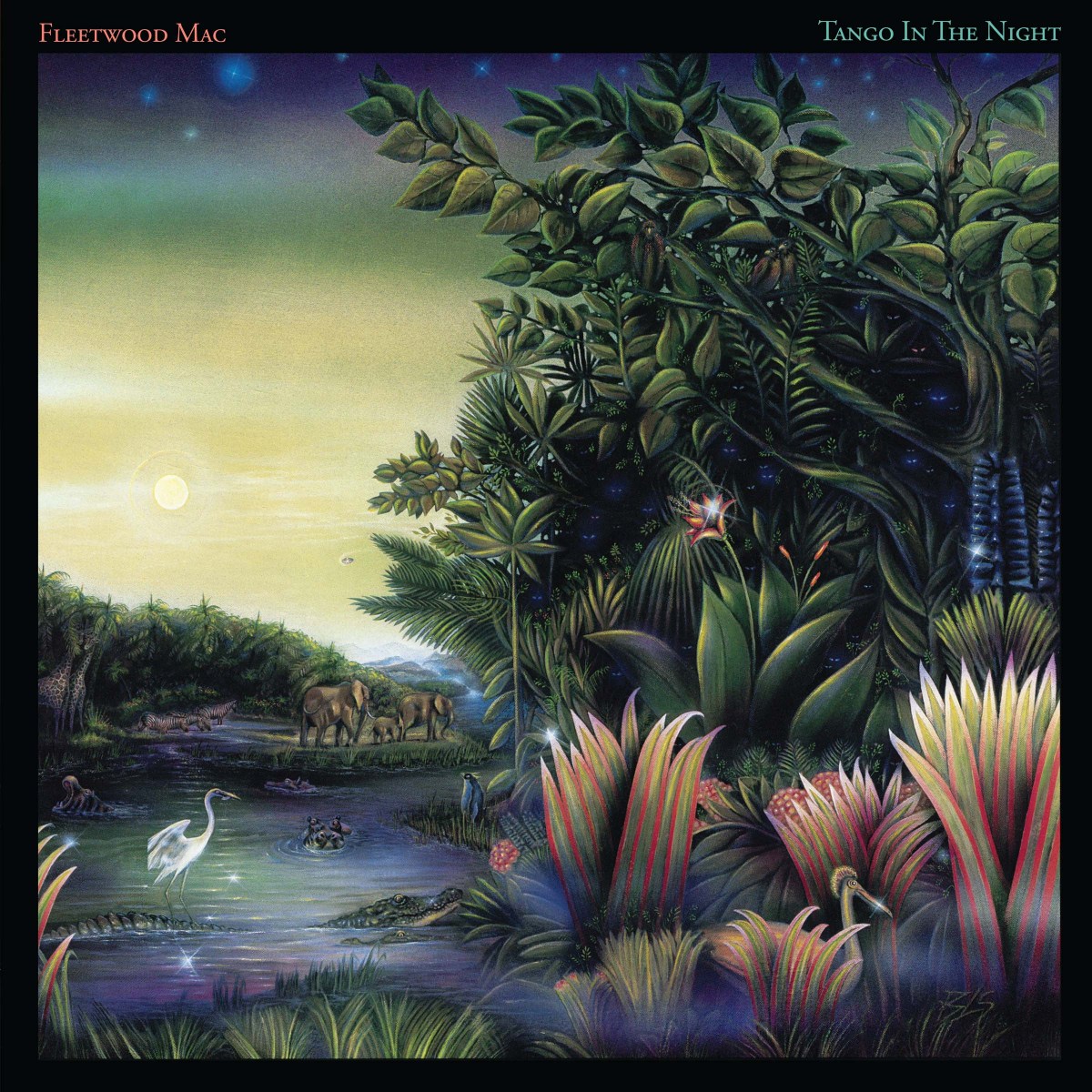
1987 studio album by Fleetwood Mac
Tango in the Night is the fourteenth studio album by British-American rock band Fleetwood Mac, released on 13 April 1987 by Warner Records. As a result of Lindsey Buckingham`s departure later that year, it is the fifth and final studio album with the band`s most successful lineup of Buckingham, Mick Fleetwood, Christine McVie, John McVie, and Stevie Nicks,[1] though Christine McVie would make guest appearances on the band`s 2003 album, Say You Will. This lineup was not seen again until 1997`s live album The Dance.
Leer másÁlbums chronology
Tango in the Night
Fleetwood Mac
Discográfica: Warner Bros. · Estudio de grabación: Rumbo Recorders and the Slope (Los Angeles, California) · Productor: Lindsey Buckingham , Richard Dashut
CHARTS
|
1
|
Big Love
Fleetwood Mac •
w: Lindsey Buckingham •
v: Buckingham •
1987 /04 /13
|
3:41 |
|
|
|
2
|
Seven Wonders
Fleetwood Mac •
w: Sandy Stewart · Stevie Nicks •
v: Nicks •
1987 /04 /13
|
3:43 |
|
|
|
3
|
Everywhere
Fleetwood Mac •
w: Christine McVie •
v: C. McVie •
1987 /04 /13
|
3:47 |
|
|
|
4
|
Caroline
Fleetwood Mac •
w: Buckingham •
v: Buckingham •
1987 /04 /13
|
3:55 |
|
|
|
5
|
Tango in the Night
Fleetwood Mac •
w: Buckingham •
v: Buckingham •
1987 /04 /13
|
4:02 |
|
|
|
6
|
Mystified
Fleetwood Mac •
w: Buckingham · C. McVie •
v: C. McVie •
1987 /04 /13
|
3:10 |
|
|
|
7
|
Little Lies
Fleetwood Mac •
w: C. McVie, Quintela •
v: C. McVie •
1987 /04 /13
|
3:41 |
|
|
|
8
|
Family Man
Fleetwood Mac •
w: Buckingham · Richard Dashut •
v: Buckingham •
1987 /04 /13
|
4:07 |
|
|
|
9
|
Welcome to the Room...Sara
Fleetwood Mac •
w: Nicks •
v: Nicks •
1987 /04 /13
|
3:42 |
|
|
|
10
|
Isn't It Midnight
Fleetwood Mac •
w: C. McVie · Quintela · Buckingham •
v: C. McVie •
1987 /04 /13
|
4:13 |
|
|
|
11
|
When I See You Again
Fleetwood Mac •
w: Nicks •
v: Nicks with Buckingham •
1987 /04 /13
|
3:49 |
|
|
|
12
|
You and I, Part II
Fleetwood Mac •
w: Buckingham · C. McVie •
v: Buckingham •
1987 /04 /13
|
2:38 |
|
Singles
Big Love
Fecha Lanzamiento: 23 Marzo 1987 · Fecha Grabación: 1987 -Discográfica: Warner Bros. · · Productor: Lindsey Buckingham , Richard Dashut
CHARTS
UK
US
AUS
CAN
GER
IRL
NL
NZ
CERTIFICATIONS
|
1
|
Big Love
Fleetwood Mac •
w: Lindsey Buckingham •
v: Buckingham •
1987 /03 /23
|
3:41 |
|
|
|
2
|
You and I, Part I
Fleetwood Mac •
1987 /03 /23
|
0:00 |
|
Seven Wonders
Fecha Lanzamiento: Junio 1987 · Fecha Grabación: 1986 -Discográfica: Warner Bros. · · Productor: Lindsey Buckingham , Richard Dashut
CHARTS
UK
US
AUS
CAN
GER
IRL
NL
NZ
CERTIFICATIONS
|
1
|
Seven Wonders
Fleetwood Mac •
w: Sandy Stewart · Stevie Nicks •
v: Nicks •
1987 /06
|
3:43 |
|
|
|
2
|
Book of Miracles
Fleetwood Mac •
1987 /06
|
0:00 |
|
Little Lies
Fecha Lanzamiento: Agosto 1987 · Fecha Grabación: 1987 -Discográfica: Warner Bros. · · Productor: Lindsey Buckingham , Richard Dashut
CHARTS
UK
US
AUS
CAN
GER
IRL
NL
NZ
CERTIFICATIONS
|
1
|
Little Lies
Fleetwood Mac •
w: C. McVie, Quintela •
v: C. McVie •
1987 /08
|
3:41 |
|
|
|
2
|
Ricky
Fleetwood Mac •
1987 /08
|
0:00 |
|
Everywhere
Fecha Lanzamiento: Noviembre 1987 · Fecha Grabación: 1987 -Discográfica: Warner Bros. · · Productor: Lindsey Buckingham , Richard Dashut
CHARTS
UK
US
AUS
CAN
IRL
NL
NZ
CERTIFICATIONS
RMNZ: 6x Platinum
|
1
|
Everywhere
Fleetwood Mac •
w: Christine McVie •
v: C. McVie •
1987 /11
|
3:47 |
|
|
|
2
|
When I See You Again
Fleetwood Mac •
w: Nicks •
v: Nicks with Buckingham •
1987 /11
|
3:49 |
|
Family Man
Fecha Lanzamiento: 30 Noviembre 1987 · Fecha Grabación: 1986 -Discográfica: Warner Bros. · · Productor: Lindsey Buckingham , Richard Dashut
CHARTS
UK
US
AUS
GER
NL
NZ
|
1
|
Family Man
Fleetwood Mac •
w: Buckingham · Richard Dashut •
v: Buckingham •
1987 /11 /30
|
4:07 |
|
|
|
2
|
Down Endless Street
Fleetwood Mac •
1987 /11 /30
|
0:00 |
|
Isnt It Midnight
Fecha Lanzamiento: 6 Junio 1988 · Fecha Grabación: 1987 -Discográfica: Warner Bros. · · Productor: Lindsey Buckingham , Richard Dashut
CHARTS
UK
AUS
CAN
GER
IRL
NL
NZ
|
1
|
Isnt It Midnight
Fleetwood Mac •
w: C. McVie · Quintela · Buckingham •
v: C. McVie •
1988 /06 /06
|
4:13 |
|
|
|
2
|
Mystified
Fleetwood Mac •
w: Buckingham · C. McVie •
v: C. McVie •
1988 /06 /06
|
3:10 |
|
| Tango in the Night | ||||
|---|---|---|---|---|
 | ||||
| Studio album by | ||||
| Released | 13 April 1987 | |||
| Recorded | November 1985 – March 1987 | |||
| Studio | Rumbo Recorders and the Slope (Los Angeles, California) | |||
| Genre | ||||
| Length | 44:28 | |||
| Label | Warner Bros. | |||
| Producer | ||||
| Fleetwood Mac chronology | ||||
| ||||
| Singles from Tango in the Night | ||||
| ||||
Review
1987 studio album by Fleetwood Mac
Tango in the Night is the fourteenth studio album by British-American rock band Fleetwood Mac, released on 13 April 1987 by Warner Records. As a result of Lindsey Buckingham`s departure later that year, it is the fifth and final studio album with the band`s most successful lineup of Buckingham, Mick Fleetwood, Christine McVie, John McVie, and Stevie Nicks,[1] though Christine McVie would make guest appearances on the band`s 2003 album, Say You Will. This lineup was not seen again until 1997`s live album The Dance.
Leer másProduced by Buckingham with Richard Dashut, Tango in the Night began as one of Buckingham`s solo projects, but in 1985, the production had morphed into Fleetwood Mac`s next record. It contains several hit singles, including four US top 20 hits: "Big Love" (No. 5), "Seven Wonders" (No. 19), "Little Lies" (No. 4), and "Everywhere" (No. 14). Two additional songs, "Family Man" (No. 90) and "Isn`t It Midnight", were released as singles to lower chart success. Tango in the Night has sold over 15 million copies worldwide.[3][4] In March 2017, remastered deluxe editions of Tango in the Night were released, the first as a double-CD set and the second as a 3CD/1DVD/1-LP boxset.[5]
Background
After the completion of the Mirage Tour in 1982, four members of Fleetwood Mac released five solo albums, with varying degrees of success. Mick Fleetwood, Christine McVie, and Lindsey Buckingham each released one, while Stevie Nicks issued two.[6]
In 1985, Christine McVie was asked to record a cover of Elvis Presley`s "Can`t Help Falling in Love" for the soundtrack of the movie A Fine Mess. Richard Dashut, who had engineered and produced Rumours, Tusk, and Mirage, was brought in to assist with the song`s production. Buckingham, Fleetwood, and John McVie were enlisted to supply the instrumentation. Greg Droman, a relatively new producer at the time, was also asked to engineer the song after an encounter with Dashut at a recording studio owned by Captain & Tennille.[7] A few weeks later, Droman worked with Buckingham on "Time Bomb Town" for the Back to the Future film soundtrack. Buckingham retained Droman to engineer what was intended to be his third solo album, although the project eventually morphed into a Fleetwood Mac album once other members got involved.[7]
Fleetwood Mac originally planned to work with an outside producer and first worked with Nile Rodgers, but the collaboration fell through. Record producer Mo Ostin then paired the band with Jason Corsaro, who had worked with the Power Station. The band then booked Studio One and rehearsed for a week without Stevie Nicks, who was in Australia touring with Tom Petty and Bob Dylan.[8] Nothing came of these sessions, so Fleetwood Mac instead used the production team of Buckingham and Dashut, with Droman as an engineer.[9][10]
Composition
Some of Buckingham`s compositions on Tango in the Night, including "Big Love" and "Family Man", were originally developed for his shelved solo album. These songs were mostly complete by the time Buckingham presented them to the band, although he recalled that "Family Man" was "sweetened up" during the mixing process. The band also sifted through Buckingham`s demos and selected "Caroline", which he had written a few years prior.[11]
Three songs on the album were co-written by Buckingham and Christine McVie.[12] McVie remarked that the two "didn`t sit down at a piano and decide the chords together", but believed that the creative process during the Tango in the Night sessions was more collaborative than their past efforts.[13]
Recording
After the release of Mirage, John McVie had spent much of his time sailing the Caribbean island of Saint Thomas and barely played bass in the years leading up to the making of Tango in the Night. In an attempt to be more productive in the studio, he quit drinking cold turkey, though this proved to be unsuccessful, and he grew concerned that he had lost his ability to play.[8] Mick Fleetwood stated that his cocaine use during the recording of Tango in the Night was worse than the Rumours sessions; Buckingham placed a Winnebago in his driveway for Fleetwood and his friends when their drug use impeded productivity in the recording studio.[14]
Dashut and Droman recalled that the album`s recording sessions were particularly tedious, even by Fleetwood Mac standards. The band recorded certain parts in half-speed to find suitable textures. This would double the song`s duration, which made for "a brutal ten minutes to listen to", according to Droman. By recording parts in half-speed, they managed to make each song sound "open and airy". "When you record something really slow and you speed it up, all the harmonics get shifted up. You end up with this high end, this tinkly little high end, that wouldn`t exist [otherwise]. There`s not another way you could get that, at least back then."[7]
Although the record took eighteen months to complete, Stevie Nicks spent a total of two weeks in the studio with the band. She was promoting Rock a Little throughout this period and sent the band demos while she was on tour. One of those songs, "Welcome to the Room... Sara", was inspired by her thirty-day stay at the Betty Ford Center to overcome her cocaine addiction in October 1986 (Nicks used the pseudonym "Sara Anderson" when she checked into the facility).[15]
When Nicks did go to the studio, she often felt unmotivated: "I can remember going up there and not being happy to even be there... I didn`t go very often." Vocal sessions took place in Buckingham`s master bedroom, where Nicks frequently recorded her parts for Buckingham and McVie`s songs under the influence of alcohol; Buckingham deleted most of Nicks` vocals after she left the studio. She later said, "I`m not blaming him for that because I`m sure they totally sucked. Vocals done when you`re crazy and drinking a cup of brandy probably aren`t usually going to be great."[16][17]
Buckingham recorded some of the vocals using a Fairlight, an early sampling synthesizer.[18] On "When I See You Again", he re-assembled separately recorded takes of Nicks, explaining, "I had to pull performances out of words and lines and make parts that sounded like her that weren`t her."[19] "That was in my estimation when everybody in the band was personally at their worst. By the time we did Tango in the Night, everybody was leading their lives in a way that they would not be too proud of today."[20]
Cover art
The album`s cover is a painting by Australian artist Brett-Livingstone Strong that was hanging in Buckingham`s house.[21][22] Titled "Homage a Henri Rousseau", it is an homage to the 19th-century French painter Henri Rousseau, emulating his colorful jungle theme on works such as The Snake Charmer and The Repast of the Lion.[21][22] It also mimics "Rousseau`s studious approach to depicting motion and activity within a still, naturalistic container; the jungle flora, the twinkling water, and the distant animals provide a sense of dreamy wanderlust and desire, but the image is frozen and vast, like the only thing that can disturb its peace is the arrival of a warm breeze".[22]
Pitchfork`s Ivy Nelson said that the artwork was "so lush and romantic that it walks a fine line between formal elegance and kitsch, blending the terrestrial with the celestial. It`s an accurate illustration of Tango in the Night`s sound design, of the glitterings and humid shimmers that Buckingham placed in the songs".[21]
The painting was also used as the cover art for "Big Love", the album`s lead single.
Release
With pressure on Buckingham to keep the project focused and moving forward, things came to a head shortly after the release of Tango in the Night. At a band meeting at Christine McVie`s house to discuss the accompanying tour, he announced his departure, which infuriated Nicks. She physically attacked Buckingham, and the ensuing fight between the ex-lovers spilled into the street.[23]
Fleetwood noted that the album "was well received. Somewhat sadly, the kudos of that was never really fully attributed to Lindsey because he wasn`t present... He was coerced and persuaded to do that album—mainly by me. And, to his credit, he put aside everything that he`d dreamt of doing, including making his own album, for Fleetwood Mac, but then realised that he`d made a mistake... Lindsey was not being heard. We just didn`t get it."[24] Buckingham partially attributed his decision to leave Fleetwood Mac to the rigours of touring, which he believed would have exacerbated the interpersonal turbulence experienced in the studio. He later said, "Compared to making an album, in my experience, going on the road will multiply the craziness by times five. I just wasn`t up for that."[25] Following Buckingham`s departure, guitarists Rick Vito and Billy Burnette were hired to replace him on the subsequent tour.[20]
Deluxe edition
A deluxe edition of Tango in the Night was issued on 31 March 2017, to celebrate the album`s 30th anniversary.[26] Included in the set were three CDs, divided into the original album with remastered sound, rare and unreleased recordings, and 12" remixes; a 180-gram vinyl LP; and a DVD, with different music videos and a high-resolution stereo version of the album.[27][28]
Disc two of the collection features the B-sides "Ricky", "Down Endless Street", and "Book of Miracles"; both halves of "You and I", released and combined for the first time; and demos, alternate versions, and other recordings.[27] The third disc features multiple remixes of "Big Love", "Seven Wonders", "Little Lies", "Family Man", and "Everywhere", either done by Arthur Baker or John "Jellybean" Benitez.[27][29][30]
Critical reception
| Review scores | |
|---|---|
| Source | Rating |
| AllMusic | [31] |
| Blender | [32] |
| Chicago Sun-Times | [33] |
| The Guardian | [34] |
| Los Angeles Times | [35] |
| Mojo | [36] |
| Pitchfork | 8.7/10[19] |
| The Rolling Stone Album Guide | [37] |
| The Village Voice | B+[38] |
Tango in the Night has mostly received positive reviews. Alex Henderson of AllMusic praised Buckingham`s contributions to the album, saying that his "thoughtful use of synthesizers were a major asset" and that he "consistently [brought] out the best in his colleagues on this superb album".[31] Steve Hochman of the Los Angeles Times also singled out Buckingham`s production work, saying that "relatively conventional material [such] as McVie`s straight rocker, `Isn`t It Midnight` and Nicks` dreamy `When I See You Again` benefit from the subtly bizarre undercurrents Buckingham creates."[35] Mojo described the album as "a perfect Mac showcase for McVie and Buckingham`s musical partnership".[39]
Alexis Petridis of The Guardian wrote that the album "seems even more deserving of the `flawed masterpiece` tag than Tusk".[34] Ivy Nelson of Pitchfork was complimentary of Buckingham and McVie`s songs but reserved some criticism for Nicks, saying, "Her voice, invariably hoarse after years of cocaine abuse, often warps or fails the already incomplete material."[19] Robert Christgau thought that the album was an improvement over Mirage but failed to live up to the quality of the band`s 1975 eponymous release and Rumours.[38]
Commercial performance
Tango in the Night is the band`s second-biggest-selling studio album[40] after the phenomenally successful Rumours, which was released ten years earlier. The intervening albums, Tusk (1979) and Mirage (1982), although big sellers in key territories, had not matched their predecessor`s huge success. Tango in the Night was a worldwide hit, with several singles becoming popular all over the world. Christine McVie`s "Little Lies" and "Everywhere" in particular appear on several 1980s compilation albums.[41]
The album was a success in the United States, where it peaked at No. 7 on the Billboard 200 for three weeks, spending more than seven months within the top 20 and more than ten months within the top 40. It was certified 3× Platinum in October 2000 for selling three million copies in the US.[42] Four singles from the album reached the Billboard top 20: "Big Love" (No. 5), "Little Lies" (No. 4), "Everywhere" (No. 14), and "Seven Wonders" (No. 19).[1] The album was particularly successful in the UK, where it reached no. 1 three times during 1987–88 for a total of five weeks and spent more than eight months within the top 10 of the UK albums chart. It is the seventh-biggest-selling album of the 1980s in the UK, being certified 8× Platinum (2.4 million copies),[43] and it is still currently one of the UK`s top 100 best-selling albums of all time.[40] Three singles were top 10 hits in Britain: "Big Love" (No. 9), "Little Lies" (No. 5), and "Everywhere" (No. 4). A total of six singles were eventually taken from the album over a period of fifteen months.[1] The album spent 115 weeks in the top 75 of the UK Albums Chart.[44]
"Big Love", "Seven Wonders", "Little Lies", "Family Man", and "Everywhere" were all released as extended 12" remixes in most territories.[1]
Outtakes
Four songs from the Tango in the Night sessions did not make the final album cut and subsequently became B-sides. "You and I (Part I)" was the B-side to the single release of "Big Love".[1] "Seven Wonders" was released with the Stevie Nicks-penned instrumental track "Book of Miracles" as its B-side. This eventually became the song "Juliet" on Nicks` 1989 solo album, The Other Side of the Mirror. McVie`s "Ricky" was the B-side to "Little Lies" and Lindsey Buckingham`s "Down Endless Street" was issued as the B-side to "Family Man".[1] All these tracks would eventually be released in the deluxe version of the album, with "You and I" parts I and II being joined with a new piano bridge.[26]
Nicks contributed three additional songs that failed to make the final album. "What Has Rock & Roll Ever Done for You?" was considered, but it was replaced by "When I See You Again".[8] "Ooh My Love", like "Juliet", eventually made its way onto The Other Side of the Mirror (with its demo also being included on the deluxe edition of Tango in the Night),[27] while "Joan of Arc" remains unreleased. "I still want to record it", she explained. "The song has its really good moments but it`s not good enough to go out as that version."[16]
Two tracks, both co-written by McVie and Buckingham, also failed to appear on the final product: "Where We Belong", which incorporates Buckingham`s "folksy fingerpicking" and McVie`s "brilliant pop simplicity", was written as a duet but was later abandoned in favour of other songs.[45] The other, "Special Kind of Love", was described by Pitchfork as a "completely developed Buckingham song".[19] Both tracks later appeared on the deluxe edition of Tango in the Night.[5][26]
Track listing
| No. | Title | Writer(s) | Lead vocals | Length |
|---|---|---|---|---|
| 1. | "Big Love" | Lindsey Buckingham | Buckingham | 3:37 |
| 2. | "Seven Wonders" |
| Nicks | 3:38 |
| 3. | "Everywhere" | Christine McVie | C. McVie | 3:48 |
| 4. | "Caroline" | Buckingham | Buckingham | 3:50 |
| 5. | "Tango in the Night" | Buckingham | Buckingham | 3:56 |
| 6. | "Mystified" |
| C. McVie | 3:08 |
| No. | Title | Writer(s) | Lead vocals | Length |
|---|---|---|---|---|
| 1. | "Little Lies" |
| C. McVie | 3:40 |
| 2. | "Family Man" |
| Buckingham | 4:08 |
| 3. | "Welcome to the Room... Sara" | Nicks | Nicks | 3:37 |
| 4. | "Isn`t It Midnight" |
| C. McVie | 4:06 |
| 5. | "When I See You Again" | Nicks | Nicks with Buckingham | 3:49 |
| 6. | "You and I, Part II" |
| Buckingham | 2:40 |
| Total length: | 44:28 | |||
Deluxe edition
This edition includes three CDs. The first one consists of a 2017 remaster of the original album; the second one of bonus, rare, or unreleased recordings; and the third one of remixes of most of the album`s singles.
The information on disc two has been adapted from Fleetwood Mac`s official website.[46]
| No. | Title | Writer(s) | Lead vocals | Length |
|---|---|---|---|---|
| 1. | "Down Endless Street" (B-side of "Family Man") | Lindsey Buckingham | Buckingham | 4:28 |
| 2. | "Special Kind of Love" (demo) | Buckingham | Buckingham | 2:53 |
| 3. | "Seven Wonders" (early version) |
| Nicks | 4:34 |
| 4. | "Tango in the Night" (demo) | Buckingham | Buckingham | 4:41 |
| 5. | "Mystified" (alternate version) |
| C. McVie | 3:27 |
| 6. | "Book of Miracles" (instrumental; B-side of "Seven Wonders") |
| 4:30 | |
| 7. | "Where We Belong" (demo) |
| Buckingham with C. McVie | 2:52 |
| 8. | "Ricky" (B-side of "Little Lies") |
| C. McVie | 4:25 |
| 9. | "Juliet" (run-through) | Nicks | Nicks | 5:04 |
| 10. | "Isn`t it Midnight" (alternate mix) |
| C. McVie | 3:39 |
| 11. | "Ooh My Love" (demo) |
| Nicks | 3:52 |
| 12. | "Mystified" (instrumental demo) |
| 3:27 | |
| 13. | "You and I, Part II" (full version) |
| Buckingham | 6:26 |
| Total length: | 54:18 | |||
Personnel
Fleetwood Mac
- Lindsey Buckingham – vocals, guitars, keyboards, Fairlight CMI, bass, percussion, drum programming
- Stevie Nicks – vocals
- Christine McVie – vocals, keyboards, synthesizers
- John McVie – bass guitar
- Mick Fleetwood – drums, percussion
Production
- Lindsey Buckingham – producer, arrangements, additional engineer, cover concept
- Richard Dashut – producer, cover concept
- Greg Droman – engineer
- Stephen Marcussen – mastering at Precision Lacquer (Hollywood, California)
- John Courage – studio coordinator
- Roy Hopper – studio crew
- Ray Lindsey – studio crew
- Steve Matteucci – studio crew
- Brett-Livingstone Strong – cover painting
- Greg Gorman – cover photography
- Jeri Heiden – art direction
Charts
Weekly charts
| Year-end charts
Decade-end charts
|
Certifications and sales
| Region | Certification | Certified units/sales |
|---|---|---|
| Australia (ARIA)[91] | 4× Platinum | 300,000[3] |
| Australia (ARIA)[92] video | Gold | 7,500^ |
| Canada (Music Canada)[93] | 5× Platinum | 500,000^ |
| Denmark (IFPI Danmark)[94] | Gold | 10,000‡ |
| Germany (BVMI)[95] | 2× Platinum | 1,000,000^ |
| Hong Kong (IFPI Hong Kong)[96] | Gold | 10,000* |
| Italy | — | 100,000[97] |
| Netherlands (NVPI)[98] | Platinum | 100,000^ |
| New Zealand (RMNZ)[99] | Platinum | 15,000^ |
| Spain (PROMUSICAE)[100] | Platinum | 100,000^ |
| Switzerland (IFPI Switzerland)[101] | Platinum | 50,000^ |
| United Kingdom (BPI)[103] | 8× Platinum | 2,500,000[102] |
| United States (RIAA)[42] | 3× Platinum | 3,000,000^ |
| United States (RIAA)[104] video | Gold | 50,000^ |
| Summaries | ||
| Worldwide | — | 15,000,000[3][4] |
* Sales figures based on certification alone. | ||
1987 studio album by Fleetwood Mac
Tango in the Night is the fourteenth studio album by British-American rock band Fleetwood Mac, released on 13 April 1987 by Warner Records. As a result of Lindsey Buckingham`s departure later that year, it is the fifth and final studio album with the band`s most successful lineup of Buckingham, Mick Fleetwood, Christine McVie, John McVie, and Stevie Nicks,[1] though Christine McVie would make guest appearances on the band`s 2003 album, Say You Will. This lineup was not seen again until 1997`s live album The Dance.
Produced by Buckingham with Richard Dashut, Tango in the Night began as one of Buckingham`s solo projects, but in 1985, the production had morphed into Fleetwood Mac`s next record. It contains several hit singles, including four US top 20 hits: "Big Love" (No. 5), "Seven Wonders" (No. 19), "Little Lies" (No. 4), and "Everywhere" (No. 14). Two additional songs, "Family Man" (No. 90) and "Isn`t It Midnight", were released as singles to lower chart success. Tango in the Night has sold over 15 million copies worldwide.[3][4] In March 2017, remastered deluxe editions of Tango in the Night were released, the first as a double-CD set and the second as a 3CD/1DVD/1-LP boxset.[5]
Background
After the completion of the Mirage Tour in 1982, four members of Fleetwood Mac released five solo albums, with varying degrees of success. Mick Fleetwood, Christine McVie, and Lindsey Buckingham each released one, while Stevie Nicks issued two.[6]
In 1985, Christine McVie was asked to record a cover of Elvis Presley`s "Can`t Help Falling in Love" for the soundtrack of the movie A Fine Mess. Richard Dashut, who had engineered and produced Rumours, Tusk, and Mirage, was brought in to assist with the song`s production. Buckingham, Fleetwood, and John McVie were enlisted to supply the instrumentation. Greg Droman, a relatively new producer at the time, was also asked to engineer the song after an encounter with Dashut at a recording studio owned by Captain & Tennille.[7] A few weeks later, Droman worked with Buckingham on "Time Bomb Town" for the Back to the Future film soundtrack. Buckingham retained Droman to engineer what was intended to be his third solo album, although the project eventually morphed into a Fleetwood Mac album once other members got involved.[7]
Fleetwood Mac originally planned to work with an outside producer and first worked with Nile Rodgers, but the collaboration fell through. Record producer Mo Ostin then paired the band with Jason Corsaro, who had worked with the Power Station. The band then booked Studio One and rehearsed for a week without Stevie Nicks, who was in Australia touring with Tom Petty and Bob Dylan.[8] Nothing came of these sessions, so Fleetwood Mac instead used the production team of Buckingham and Dashut, with Droman as an engineer.[9][10]
Composition
Some of Buckingham`s compositions on Tango in the Night, including "Big Love" and "Family Man", were originally developed for his shelved solo album. These songs were mostly complete by the time Buckingham presented them to the band, although he recalled that "Family Man" was "sweetened up" during the mixing process. The band also sifted through Buckingham`s demos and selected "Caroline", which he had written a few years prior.[11]
Three songs on the album were co-written by Buckingham and Christine McVie.[12] McVie remarked that the two "didn`t sit down at a piano and decide the chords together", but believed that the creative process during the Tango in the Night sessions was more collaborative than their past efforts.[13]
Recording
After the release of Mirage, John McVie had spent much of his time sailing the Caribbean island of Saint Thomas and barely played bass in the years leading up to the making of Tango in the Night. In an attempt to be more productive in the studio, he quit drinking cold turkey, though this proved to be unsuccessful, and he grew concerned that he had lost his ability to play.[8] Mick Fleetwood stated that his cocaine use during the recording of Tango in the Night was worse than the Rumours sessions; Buckingham placed a Winnebago in his driveway for Fleetwood and his friends when their drug use impeded productivity in the recording studio.[14]
Dashut and Droman recalled that the album`s recording sessions were particularly tedious, even by Fleetwood Mac standards. The band recorded certain parts in half-speed to find suitable textures. This would double the song`s duration, which made for "a brutal ten minutes to listen to", according to Droman. By recording parts in half-speed, they managed to make each song sound "open and airy". "When you record something really slow and you speed it up, all the harmonics get shifted up. You end up with this high end, this tinkly little high end, that wouldn`t exist [otherwise]. There`s not another way you could get that, at least back then."[7]
Although the record took eighteen months to complete, Stevie Nicks spent a total of two weeks in the studio with the band. She was promoting Rock a Little throughout this period and sent the band demos while she was on tour. One of those songs, "Welcome to the Room... Sara", was inspired by her thirty-day stay at the Betty Ford Center to overcome her cocaine addiction in October 1986 (Nicks used the pseudonym "Sara Anderson" when she checked into the facility).[15]
When Nicks did go to the studio, she often felt unmotivated: "I can remember going up there and not being happy to even be there... I didn`t go very often." Vocal sessions took place in Buckingham`s master bedroom, where Nicks frequently recorded her parts for Buckingham and McVie`s songs under the influence of alcohol; Buckingham deleted most of Nicks` vocals after she left the studio. She later said, "I`m not blaming him for that because I`m sure they totally sucked. Vocals done when you`re crazy and drinking a cup of brandy probably aren`t usually going to be great."[16][17]
Buckingham recorded some of the vocals using a Fairlight, an early sampling synthesizer.[18] On "When I See You Again", he re-assembled separately recorded takes of Nicks, explaining, "I had to pull performances out of words and lines and make parts that sounded like her that weren`t her."[19] "That was in my estimation when everybody in the band was personally at their worst. By the time we did Tango in the Night, everybody was leading their lives in a way that they would not be too proud of today."[20]
Cover art
The album`s cover is a painting by Australian artist Brett-Livingstone Strong that was hanging in Buckingham`s house.[21][22] Titled "Homage a Henri Rousseau", it is an homage to the 19th-century French painter Henri Rousseau, emulating his colorful jungle theme on works such as The Snake Charmer and The Repast of the Lion.[21][22] It also mimics "Rousseau`s studious approach to depicting motion and activity within a still, naturalistic container; the jungle flora, the twinkling water, and the distant animals provide a sense of dreamy wanderlust and desire, but the image is frozen and vast, like the only thing that can disturb its peace is the arrival of a warm breeze".[22]
Pitchfork`s Ivy Nelson said that the artwork was "so lush and romantic that it walks a fine line between formal elegance and kitsch, blending the terrestrial with the celestial. It`s an accurate illustration of Tango in the Night`s sound design, of the glitterings and humid shimmers that Buckingham placed in the songs".[21]
The painting was also used as the cover art for "Big Love", the album`s lead single.
Release
With pressure on Buckingham to keep the project focused and moving forward, things came to a head shortly after the release of Tango in the Night. At a band meeting at Christine McVie`s house to discuss the accompanying tour, he announced his departure, which infuriated Nicks. She physically attacked Buckingham, and the ensuing fight between the ex-lovers spilled into the street.[23]
Fleetwood noted that the album "was well received. Somewhat sadly, the kudos of that was never really fully attributed to Lindsey because he wasn`t present... He was coerced and persuaded to do that album—mainly by me. And, to his credit, he put aside everything that he`d dreamt of doing, including making his own album, for Fleetwood Mac, but then realised that he`d made a mistake... Lindsey was not being heard. We just didn`t get it."[24] Buckingham partially attributed his decision to leave Fleetwood Mac to the rigours of touring, which he believed would have exacerbated the interpersonal turbulence experienced in the studio. He later said, "Compared to making an album, in my experience, going on the road will multiply the craziness by times five. I just wasn`t up for that."[25] Following Buckingham`s departure, guitarists Rick Vito and Billy Burnette were hired to replace him on the subsequent tour.[20]
Deluxe edition
A deluxe edition of Tango in the Night was issued on 31 March 2017, to celebrate the album`s 30th anniversary.[26] Included in the set were three CDs, divided into the original album with remastered sound, rare and unreleased recordings, and 12" remixes; a 180-gram vinyl LP; and a DVD, with different music videos and a high-resolution stereo version of the album.[27][28]
Disc two of the collection features the B-sides "Ricky", "Down Endless Street", and "Book of Miracles"; both halves of "You and I", released and combined for the first time; and demos, alternate versions, and other recordings.[27] The third disc features multiple remixes of "Big Love", "Seven Wonders", "Little Lies", "Family Man", and "Everywhere", either done by Arthur Baker or John "Jellybean" Benitez.[27][29][30]
Critical reception
| Review scores | |
|---|---|
| Source | Rating |
| AllMusic | [31] |
| Blender | [32] |
| Chicago Sun-Times | [33] |
| The Guardian | [34] |
| Los Angeles Times | [35] |
| Mojo | [36] |
| Pitchfork | 8.7/10[19] |
| The Rolling Stone Album Guide | [37] |
| The Village Voice | B+[38] |
Tango in the Night has mostly received positive reviews. Alex Henderson of AllMusic praised Buckingham`s contributions to the album, saying that his "thoughtful use of synthesizers were a major asset" and that he "consistently [brought] out the best in his colleagues on this superb album".[31] Steve Hochman of the Los Angeles Times also singled out Buckingham`s production work, saying that "relatively conventional material [such] as McVie`s straight rocker, `Isn`t It Midnight` and Nicks` dreamy `When I See You Again` benefit from the subtly bizarre undercurrents Buckingham creates."[35] Mojo described the album as "a perfect Mac showcase for McVie and Buckingham`s musical partnership".[39]
Alexis Petridis of The Guardian wrote that the album "seems even more deserving of the `flawed masterpiece` tag than Tusk".[34] Ivy Nelson of Pitchfork was complimentary of Buckingham and McVie`s songs but reserved some criticism for Nicks, saying, "Her voice, invariably hoarse after years of cocaine abuse, often warps or fails the already incomplete material."[19] Robert Christgau thought that the album was an improvement over Mirage but failed to live up to the quality of the band`s 1975 eponymous release and Rumours.[38]
Commercial performance
Tango in the Night is the band`s second-biggest-selling studio album[40] after the phenomenally successful Rumours, which was released ten years earlier. The intervening albums, Tusk (1979) and Mirage (1982), although big sellers in key territories, had not matched their predecessor`s huge success. Tango in the Night was a worldwide hit, with several singles becoming popular all over the world. Christine McVie`s "Little Lies" and "Everywhere" in particular appear on several 1980s compilation albums.[41]
The album was a success in the United States, where it peaked at No. 7 on the Billboard 200 for three weeks, spending more than seven months within the top 20 and more than ten months within the top 40. It was certified 3× Platinum in October 2000 for selling three million copies in the US.[42] Four singles from the album reached the Billboard top 20: "Big Love" (No. 5), "Little Lies" (No. 4), "Everywhere" (No. 14), and "Seven Wonders" (No. 19).[1] The album was particularly successful in the UK, where it reached no. 1 three times during 1987–88 for a total of five weeks and spent more than eight months within the top 10 of the UK albums chart. It is the seventh-biggest-selling album of the 1980s in the UK, being certified 8× Platinum (2.4 million copies),[43] and it is still currently one of the UK`s top 100 best-selling albums of all time.[40] Three singles were top 10 hits in Britain: "Big Love" (No. 9), "Little Lies" (No. 5), and "Everywhere" (No. 4). A total of six singles were eventually taken from the album over a period of fifteen months.[1] The album spent 115 weeks in the top 75 of the UK Albums Chart.[44]
"Big Love", "Seven Wonders", "Little Lies", "Family Man", and "Everywhere" were all released as extended 12" remixes in most territories.[1]
Outtakes
Four songs from the Tango in the Night sessions did not make the final album cut and subsequently became B-sides. "You and I (Part I)" was the B-side to the single release of "Big Love".[1] "Seven Wonders" was released with the Stevie Nicks-penned instrumental track "Book of Miracles" as its B-side. This eventually became the song "Juliet" on Nicks` 1989 solo album, The Other Side of the Mirror. McVie`s "Ricky" was the B-side to "Little Lies" and Lindsey Buckingham`s "Down Endless Street" was issued as the B-side to "Family Man".[1] All these tracks would eventually be released in the deluxe version of the album, with "You and I" parts I and II being joined with a new piano bridge.[26]
Nicks contributed three additional songs that failed to make the final album. "What Has Rock & Roll Ever Done for You?" was considered, but it was replaced by "When I See You Again".[8] "Ooh My Love", like "Juliet", eventually made its way onto The Other Side of the Mirror (with its demo also being included on the deluxe edition of Tango in the Night),[27] while "Joan of Arc" remains unreleased. "I still want to record it", she explained. "The song has its really good moments but it`s not good enough to go out as that version."[16]
Two tracks, both co-written by McVie and Buckingham, also failed to appear on the final product: "Where We Belong", which incorporates Buckingham`s "folksy fingerpicking" and McVie`s "brilliant pop simplicity", was written as a duet but was later abandoned in favour of other songs.[45] The other, "Special Kind of Love", was described by Pitchfork as a "completely developed Buckingham song".[19] Both tracks later appeared on the deluxe edition of Tango in the Night.[5][26]
Track listing
| No. | Title | Writer(s) | Lead vocals | Length |
|---|---|---|---|---|
| 1. | "Big Love" | Lindsey Buckingham | Buckingham | 3:37 |
| 2. | "Seven Wonders" |
| Nicks | 3:38 |
| 3. | "Everywhere" | Christine McVie | C. McVie | 3:48 |
| 4. | "Caroline" | Buckingham | Buckingham | 3:50 |
| 5. | "Tango in the Night" | Buckingham | Buckingham | 3:56 |
| 6. | "Mystified" |
| C. McVie | 3:08 |
| No. | Title | Writer(s) | Lead vocals | Length |
|---|---|---|---|---|
| 1. | "Little Lies" |
| C. McVie | 3:40 |
| 2. | "Family Man" |
| Buckingham | 4:08 |
| 3. | "Welcome to the Room... Sara" | Nicks | Nicks | 3:37 |
| 4. | "Isn`t It Midnight" |
| C. McVie | 4:06 |
| 5. | "When I See You Again" | Nicks | Nicks with Buckingham | 3:49 |
| 6. | "You and I, Part II" |
| Buckingham | 2:40 |
| Total length: | 44:28 | |||
Deluxe edition
This edition includes three CDs. The first one consists of a 2017 remaster of the original album; the second one of bonus, rare, or unreleased recordings; and the third one of remixes of most of the album`s singles.
The information on disc two has been adapted from Fleetwood Mac`s official website.[46]
| No. | Title | Writer(s) | Lead vocals | Length |
|---|---|---|---|---|
| 1. | "Down Endless Street" (B-side of "Family Man") | Lindsey Buckingham | Buckingham | 4:28 |
| 2. | "Special Kind of Love" (demo) | Buckingham | Buckingham | 2:53 |
| 3. | "Seven Wonders" (early version) |
| Nicks | 4:34 |
| 4. | "Tango in the Night" (demo) | Buckingham | Buckingham | 4:41 |
| 5. | "Mystified" (alternate version) |
| C. McVie | 3:27 |
| 6. | "Book of Miracles" (instrumental; B-side of "Seven Wonders") |
| 4:30 | |
| 7. | "Where We Belong" (demo) |
| Buckingham with C. McVie | 2:52 |
| 8. | "Ricky" (B-side of "Little Lies") |
| C. McVie | 4:25 |
| 9. | "Juliet" (run-through) | Nicks | Nicks | 5:04 |
| 10. | "Isn`t it Midnight" (alternate mix) |
| C. McVie | 3:39 |
| 11. | "Ooh My Love" (demo) |
| Nicks | 3:52 |
| 12. | "Mystified" (instrumental demo) |
| 3:27 | |
| 13. | "You and I, Part II" (full version) |
| Buckingham | 6:26 |
| Total length: | 54:18 | |||
Personnel
Fleetwood Mac
- Lindsey Buckingham – vocals, guitars, keyboards, Fairlight CMI, bass, percussion, drum programming
- Stevie Nicks – vocals
- Christine McVie – vocals, keyboards, synthesizers
- John McVie – bass guitar
- Mick Fleetwood – drums, percussion
Production
- Lindsey Buckingham – producer, arrangements, additional engineer, cover concept
- Richard Dashut – producer, cover concept
- Greg Droman – engineer
- Stephen Marcussen – mastering at Precision Lacquer (Hollywood, California)
- John Courage – studio coordinator
- Roy Hopper – studio crew
- Ray Lindsey – studio crew
- Steve Matteucci – studio crew
- Brett-Livingstone Strong – cover painting
- Greg Gorman – cover photography
- Jeri Heiden – art direction
Charts
Weekly charts
| Year-end charts
Decade-end charts
|
Certifications and sales
| Region | Certification | Certified units/sales |
|---|---|---|
| Australia (ARIA)[91] | 4× Platinum | 300,000[3] |
| Australia (ARIA)[92] video | Gold | 7,500^ |
| Canada (Music Canada)[93] | 5× Platinum | 500,000^ |
| Denmark (IFPI Danmark)[94] | Gold | 10,000‡ |
| Germany (BVMI)[95] | 2× Platinum | 1,000,000^ |
| Hong Kong (IFPI Hong Kong)[96] | Gold | 10,000* |
| Italy | — | 100,000[97] |
| Netherlands (NVPI)[98] | Platinum | 100,000^ |
| New Zealand (RMNZ)[99] | Platinum | 15,000^ |
| Spain (PROMUSICAE)[100] | Platinum | 100,000^ |
| Switzerland (IFPI Switzerland)[101] | Platinum | 50,000^ |
| United Kingdom (BPI)[103] | 8× Platinum | 2,500,000[102] |
| United States (RIAA)[42] | 3× Platinum | 3,000,000^ |
| United States (RIAA)[104] video | Gold | 50,000^ |
| Summaries | ||
| Worldwide | — | 15,000,000[3][4] |
* Sales figures based on certification alone. | ||
DISCOGRAFÍA
Fleetwood Mac - Big Love (Official Music Video) · Channel: Fleetwood Mac · 3m 40s


Fleetwood Mac - Seven Wonders (Official Music Video) · Channel: Fleetwood Mac · 3m 38s

Fleetwood Mac - Everywhere (Official Music Video) · Channel: Fleetwood Mac · 3m 41s

Caroline (2017 Remaster) · Channel: Fleetwood Mac - Topic · 3m 54s

Tango in the Night (2017 Remaster) · Channel: Fleetwood Mac - Topic · 4m 3s

Mystified (2017 Remaster) · Channel: Fleetwood Mac - Topic · 3m 10s

Fleetwood Mac - Little Lies (Official Music Video) · Channel: Fleetwood Mac · 3m 38s

Family Man (2017 Remaster) · Channel: Fleetwood Mac - Topic · 4m 8s

Welcome to the Room... Sara (2017 Remaster) · Channel: Fleetwood Mac - Topic · 3m 42s

Isn't It Midnight (2017 Remaster) · Channel: Fleetwood Mac - Topic · 4m 14s

When I See You Again (2017 Remaster) · Channel: Fleetwood Mac - Topic · 3m 50s




